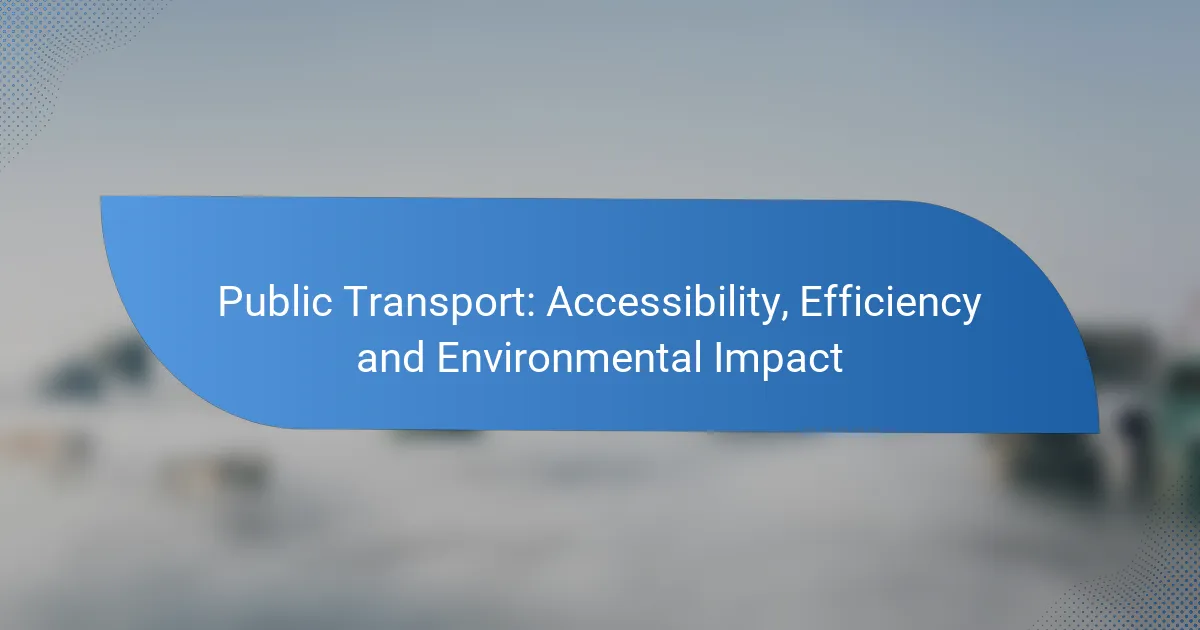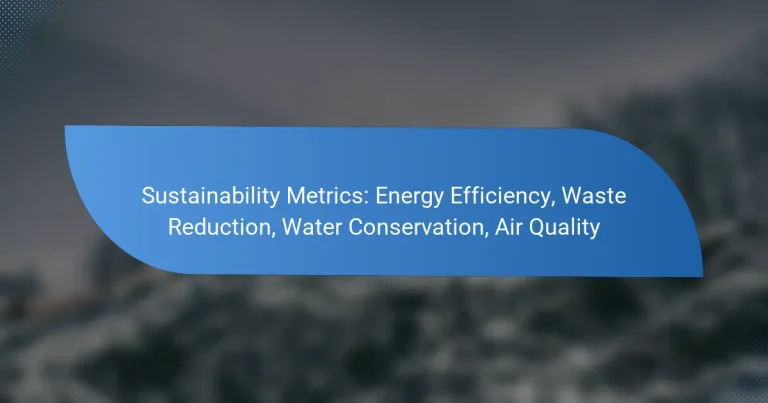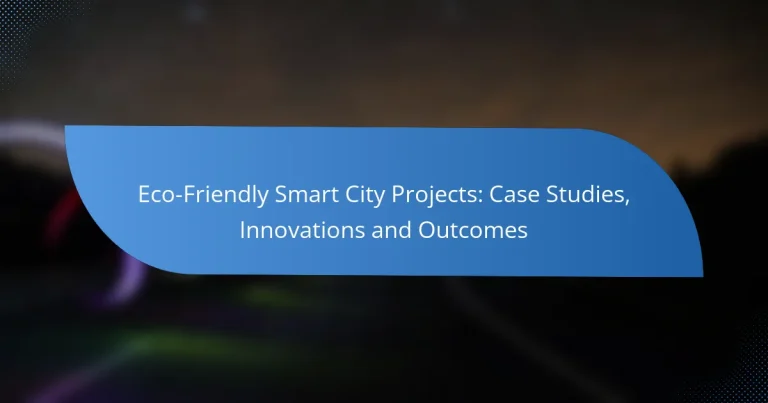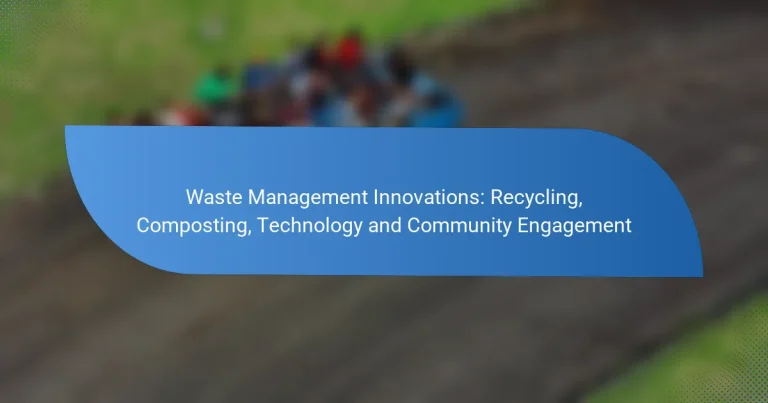Public Transport: Accessibility, Efficiency and Environmental Impact
Public transport plays a vital role in enhancing accessibility, ensuring that individuals with diverse mobility needs can reach essential services, jobs, and education. Its efficiency is measured through various metrics that reflect operational effectiveness and user satisfaction, while also significantly reducing environmental impact by lowering carbon emissions and promoting sustainable urban planning. By offering an alternative to single-occupancy vehicles, public transport contributes to cleaner air and a healthier planet.

How Does Public Transport Improve Accessibility?
Public transport enhances accessibility by providing essential services that cater to individuals with diverse mobility needs. It ensures that everyone, regardless of physical ability, can access transportation options that connect them to jobs, education, and essential services.
Wheelchair-accessible vehicles
Wheelchair-accessible vehicles are designed to accommodate individuals using wheelchairs, making public transport more inclusive. These vehicles often feature ramps or lifts, designated spaces for wheelchairs, and securement systems to ensure safety during transit.
In many urban areas, regulations require a certain percentage of public transport vehicles to be wheelchair-accessible. This can vary, but a common standard is around 20-30% of the fleet, depending on the city’s size and resources.
Real-time information systems
Real-time information systems provide up-to-date data on public transport schedules, delays, and route changes, significantly improving accessibility. These systems can be accessed via mobile apps, websites, or digital displays at stations, helping users plan their journeys effectively.
For those with mobility challenges, having access to real-time updates can prevent unnecessary waiting times and allow for better planning. Many cities are now integrating these systems with features that cater specifically to accessibility needs, such as alerts for low-floor buses or accessible routes.
Dedicated services for the visually impaired
Public transport systems often implement dedicated services for visually impaired individuals, enhancing their travel experience. This includes audio announcements on vehicles and at stations, tactile maps, and braille signage to aid navigation.
Additionally, some transit authorities offer orientation and mobility training programs to help visually impaired users become familiar with the transport system, ensuring they can travel independently and confidently.
Community outreach programs
Community outreach programs are essential for raising awareness about accessible public transport options. These programs often involve collaboration with local organizations to educate individuals about available services and how to use them effectively.
Outreach initiatives may include workshops, informational sessions, and partnerships with advocacy groups to ensure that the needs of people with disabilities are met. Engaging the community fosters a more inclusive environment and encourages feedback for continuous improvement in accessibility services.
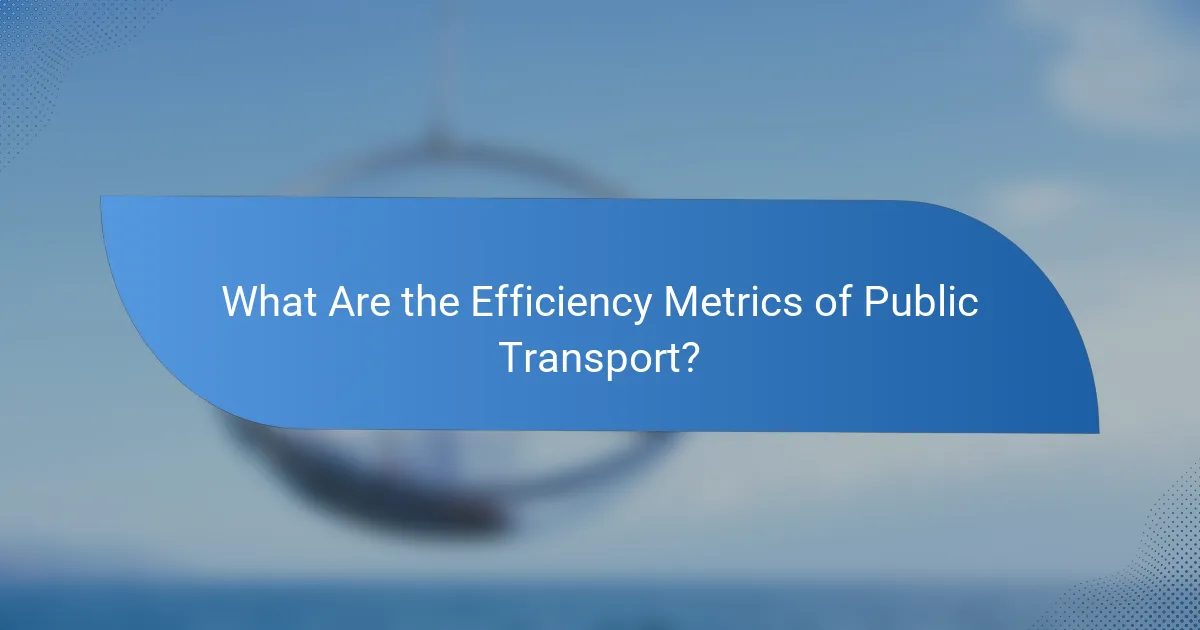
What Are the Efficiency Metrics of Public Transport?
The efficiency metrics of public transport are critical indicators that assess how well these systems operate. Key metrics include passenger load factors, on-time performance rates, cost per passenger mile, and average trip duration, each providing insights into operational effectiveness and user satisfaction.
Passenger load factors
Passenger load factors measure the average number of passengers relative to the total seating capacity of a vehicle. A higher load factor indicates better utilization of resources, which can lead to reduced operational costs and lower environmental impact. For many public transport systems, an ideal load factor typically ranges from 40% to 70% during peak hours.
To improve load factors, transport authorities can implement strategies such as dynamic pricing, which adjusts fares based on demand, or enhance service frequency during busy times. Monitoring these factors can help identify trends and optimize service delivery.
On-time performance rates
On-time performance rates indicate the percentage of scheduled trips that arrive at their destination within a designated timeframe. High on-time performance is essential for maintaining user trust and satisfaction. Many public transport systems aim for on-time rates of 80% to 95% during peak hours.
Factors affecting on-time performance include traffic congestion, weather conditions, and operational inefficiencies. To enhance punctuality, agencies can invest in dedicated bus lanes or real-time tracking systems that inform passengers about delays.
Cost per passenger mile
Cost per passenger mile is a financial metric that calculates the total operating cost divided by the total passenger miles traveled. This metric helps assess the economic efficiency of public transport systems. Typical costs can vary widely, with urban transit systems often reporting figures between $0.50 and $2.00 per passenger mile.
Reducing this cost can be achieved through measures such as optimizing routes, increasing ridership, and leveraging technology for better resource management. Understanding this metric allows transport planners to make informed decisions about pricing and service improvements.
Average trip duration
Average trip duration refers to the typical time it takes for passengers to complete their journeys on public transport. Shorter trip durations can enhance user satisfaction and encourage more people to use public transport. Average durations can vary significantly depending on the city and mode of transport, often ranging from 20 to 60 minutes for urban commutes.
To minimize trip durations, transport systems can focus on improving route efficiency, reducing stops, and implementing express services. Regularly analyzing trip duration data can help identify bottlenecks and inform future infrastructure investments.
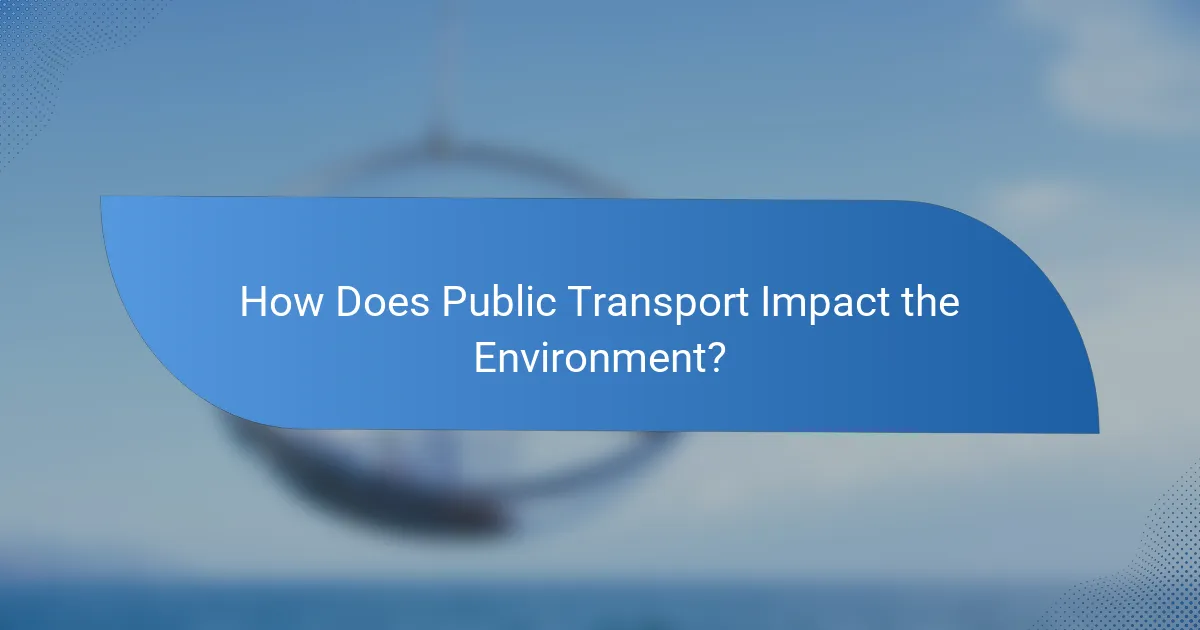
How Does Public Transport Impact the Environment?
Public transport significantly reduces environmental impact by lowering carbon emissions, promoting energy efficiency, and influencing urban planning. By providing an alternative to single-occupancy vehicles, public transport systems contribute to cleaner air and reduced greenhouse gas emissions.
Reduction in carbon emissions
Public transport systems are generally more efficient than private vehicles, leading to a substantial reduction in carbon emissions per passenger mile. For instance, buses and trains can carry many passengers simultaneously, which minimizes the overall emissions compared to multiple cars on the road.
In urban areas, a shift from cars to public transport can lead to reductions in carbon emissions by tens of percent. This shift not only benefits the environment but also improves public health by decreasing air pollution levels.
Energy-efficient vehicle technologies
Many public transport systems are adopting energy-efficient technologies, such as electric buses and hybrid vehicles, which further reduce their environmental footprint. These advancements help decrease reliance on fossil fuels and lower greenhouse gas emissions.
In some regions, regulations are pushing for cleaner technologies, with incentives for transit agencies to upgrade their fleets. This transition not only benefits the environment but can also lead to cost savings in fuel and maintenance over time.
Land use and urban planning benefits
Public transport encourages higher-density development, which can lead to more efficient land use. When cities invest in transit infrastructure, they often see a corresponding increase in mixed-use developments, which reduces the need for extensive road networks and parking spaces.
Effective urban planning that incorporates public transport can create walkable communities, reducing the reliance on cars. This shift not only lowers emissions but also enhances the quality of life for residents by promoting healthier lifestyles and reducing traffic congestion.
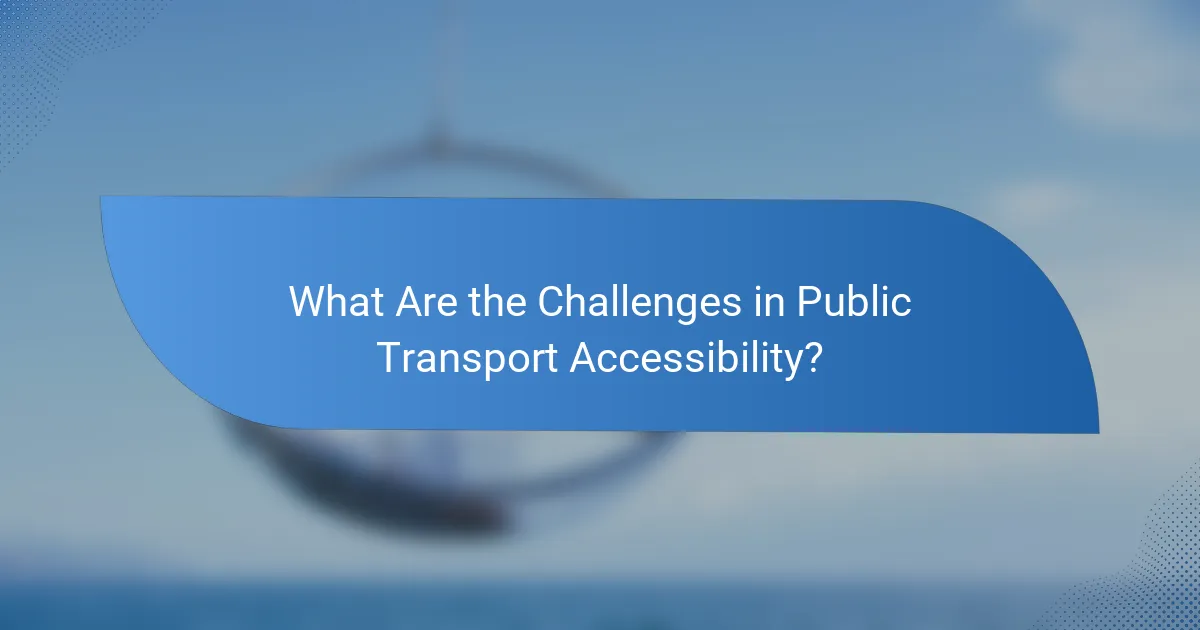
What Are the Challenges in Public Transport Accessibility?
Public transport accessibility faces several challenges that hinder the ability of all individuals, including those with disabilities, to use these services effectively. Key issues include inadequate funding, inconsistent service quality, and gaps in public awareness and education.
Lack of funding for infrastructure
Insufficient funding for public transport infrastructure limits the development and maintenance of accessible facilities. Many transit systems struggle to allocate resources for ramps, elevators, and other necessary adaptations, which can leave individuals with mobility challenges without viable options.
In many regions, budget constraints lead to prioritizing immediate operational costs over long-term accessibility improvements. This often results in outdated infrastructure that does not meet current accessibility standards, making it difficult for users to navigate the system safely.
Inconsistent service quality
The quality of public transport services can vary significantly, affecting accessibility for users. Inconsistent schedules, unreliable vehicles, and poorly trained staff can create barriers for individuals who rely on public transport for daily activities.
For example, if a bus frequently arrives late or is overcrowded, it may not accommodate individuals with disabilities effectively. Ensuring a consistent level of service is crucial for maintaining accessibility and encouraging more people to use public transport.
Public awareness and education gaps
Many individuals are unaware of the accessibility features available in public transport systems, which can discourage use. Public awareness campaigns are essential to inform users about the services designed for those with disabilities, such as priority seating and assistance programs.
Moreover, educating transport staff about accessibility needs and how to assist passengers can significantly improve the overall experience. Training programs should focus on empathy and practical skills to ensure that all users feel supported and valued while using public transport.
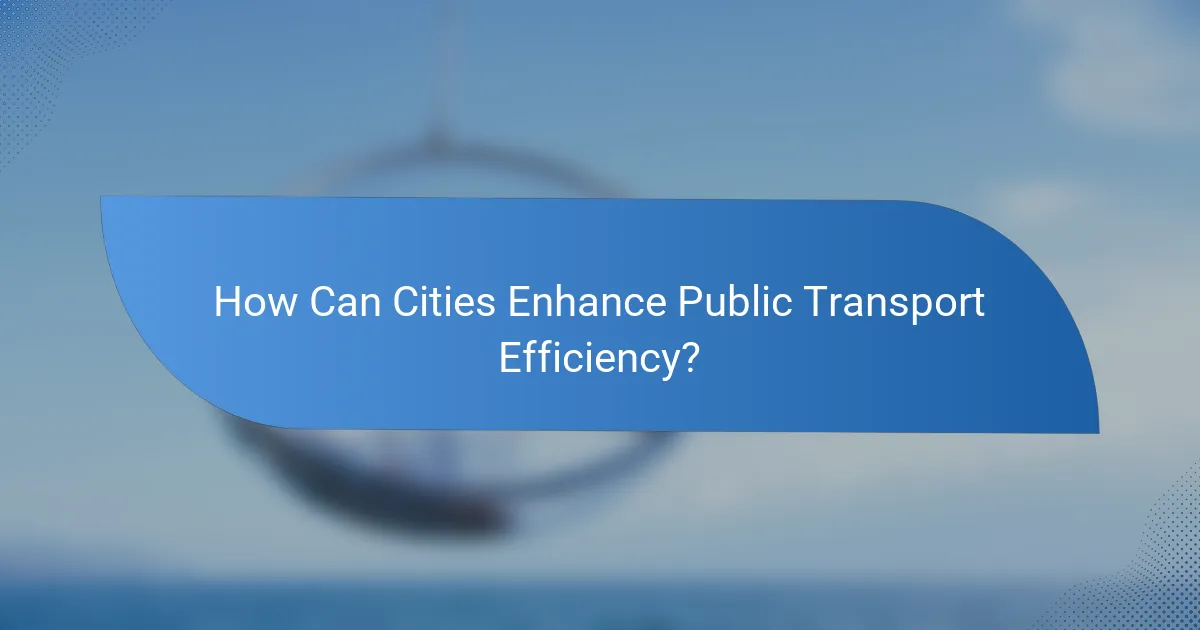
How Can Cities Enhance Public Transport Efficiency?
Cities can enhance public transport efficiency by integrating technology, optimizing routes, and improving user experience. These strategies help reduce wait times, increase ridership, and minimize operational costs.
Implementing smart transit systems
Smart transit systems utilize technology to streamline operations and improve service delivery. This includes real-time tracking of vehicles, automated fare collection, and mobile apps that provide users with up-to-date information on schedules and delays.
For instance, cities like Singapore and Barcelona have successfully implemented smart systems that allow passengers to plan their journeys efficiently, leading to higher satisfaction and increased usage. Investing in these technologies can yield significant long-term benefits, including reduced congestion and lower emissions.
Optimizing route planning
Optimizing route planning involves analyzing travel patterns to create efficient transit routes that meet the needs of the community. This can be achieved through data analysis, community feedback, and pilot programs to test new routes.
For example, cities can employ algorithms that consider factors like peak travel times and popular destinations to adjust routes dynamically. Regularly reviewing and updating routes based on ridership data can help ensure that public transport remains relevant and efficient.
